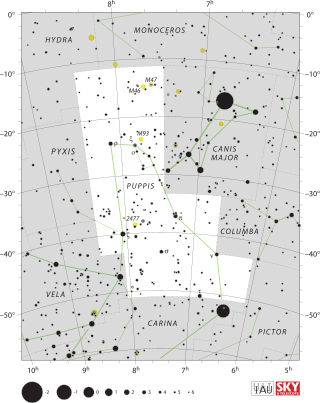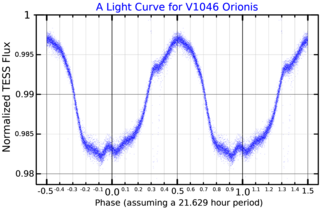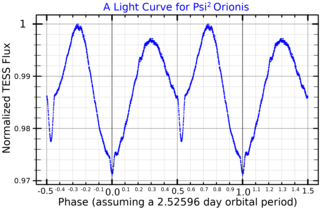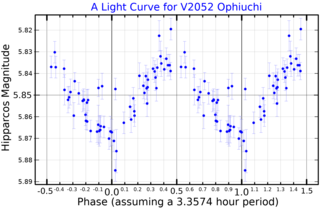
Delta Cephei is a quadruple star system located approximately 887 light-years away in the northern constellation of Cepheus, the King. At this distance, the visual magnitude of the star is diminished by 0.23 as a result of extinction caused by gas and dust along the line of sight. It is the prototype of the Cepheid variable stars that undergo periodic changes in luminosity.

9 Aurigae is a star system in Auriga (constellation). It has an apparent magnitude of about 5, making it visible to the naked eye in many suburban skies. Parallax estimates made by the Hipparcos spacecraft put it at about 86 light-years from the solar system, although individual Gaia Data Release 3 parallaxes place all three components at 88 light years.

Iota Canis Majoris, Latinized from ι Canis Majoris, is a solitary variable supergiant star in the southern constellation of Canis Major. It is visible to the naked eye with an apparent visual magnitude that varies between +4.36 and +4.40. The distance to this star is approximately 2,500 light years based on spectroscopic measurements. It is drifting further away with a radial velocity of +42 km/s.

2 Lacertae is a binary star in the constellation of Lacerta. With an apparent magnitude of about 4.5, it is faintly visible to the naked eye. Its parallax, measured by the Hipparcos spacecraft, is 5.88 milliarcseconds, corresponding to a distance of about 550 light years. It is projected against the Lacertae OB1 stellar association to the northeast of the main concentration of stars, but it is likely to be a foreground object.

Sigma Puppis, Latinized from σ Puppis, is a binary star system in the southern constellation Puppis. It has an apparent visual magnitude of 3.25, which is bright enough to be visible to the naked eye at night from the Southern Hemisphere. Through a telescope, it appears as a bright, orange-hued star with a nearby white companion. Parallax measurements indicate this star is located at a distance of about 192 light-years from Earth.

VV Cephei, also known as HD 208816, is an eclipsing binary star system located in the constellation Cepheus. It is both a B[e] star and shell star. As a 5th magnitude star, it is visible to the naked eye under good observing conditions.
V354 Cephei is a red supergiant star located within the Milky Way. It is an irregular variable located over 13,000 light-years away from the Sun. It has an estimated radius of 1,139 solar radii. If it were placed in the center of the Solar System, it would extend to between the orbits of Mars and Jupiter.

Theta2 Crucis, Latinized from θ2 Crucis, is a spectroscopic binary star in the constellation Crux. This pair of stars complete an orbit every 3.4280 days and they have a low orbital eccentricity that is close to 0.0. Theta2 Crucis is located at about 690 light-years from the Sun.
Theta Cephei, Latinized from θ Cephei, is a stellar class A7, fourth-magnitude star in the constellation Cepheus. This displays at a metallic-line Am star. It is a white-hued, single-lined spectroscopic binary system, located about 127 light-years from Earth. The pair have an orbital period of 2.5 years; the eccentricity was long thought to be low, at 0.03, but recent calculations have put it at a much higher 0.377. They are separated by 4.16 AU. The companion star is calculated to be about 400 times fainter than the primary. It is completely invisible in the spectrum, but is estimated to be a K7 main sequence star.

W Cephei is a spectroscopic binary and variable star located in the constellation Cepheus. It is thought to be a member of the Cep OB1 stellar association at about 8,000 light years. The supergiant primary star is one of the largest known stars and as well as one of the most luminous red supergiants.

HD 37017 is a binary star system in the equatorial constellation of Orion. It has the variable star designation V1046 Orionis; HD 37017 is the identifier from the Henry Draper Catalogue. The system is a challenge to view with the naked eye, being close to the lower limit of visibility with a combined apparent visual magnitude of 6.55. It is located at a distance of approximately 1,230 light years based on parallax, and is drifting further away with a radial velocity of +32 km/s. The system is part of star cluster NGC 1981.

HD 37756 is a binary star system in the equatorial constellation of Orion, positioned less than a degree to the north of the bright star Alnitak. It has a blue-white hue and is faintly visible to the naked eye with an apparent visual magnitude of 4.95. The system is located at a distance of approximately 900 light years from the Sun based on parallax, and is drifting further away with a radial velocity of +26 km/s. It is a member of the OB1b subgroup of the Orion OB1 association.

QZ Puppis is a class B2.5V star in the constellation Puppis. Its apparent magnitude is 4.5 and it is approximately 650 light years away based on parallax.

16 Lacertae is a triple star system in the northern constellation of Lacerta, located about 1,580 light years from the Sun. It has the variable star designation EN Lacertae; 16 Lacertae is the Flamsteed designation. This system is visible to the naked eye as a faint blue-white hued star with a maximum apparent visual magnitude of +5.587. It is moving closer to the Earth with a heliocentric radial velocity of –12 km/s.

Psi2 Orionis a binary star system in the equatorial constellation of Orion. It has an apparent visual magnitude of 4.6, indicating that it is visible to the naked eye. Based upon an annual parallax shift of 2.87 mass, it is roughly 1,100 light years distant from the Sun.

12 Lacertae is a wide binary star system in the northern constellation of Lacerta, located roughly 1,260 light years away from the Sun based on parallax. It is visible to the naked eye as a dim, blue-white hued point of light with a baseline apparent visual magnitude of 5.23. The system is drifting closer to the Earth with a mean heliocentric radial velocity of –12.5. It is a probable member of the I Lacertae OB association.

DH Cephei is a variable binary star system in the northern circumpolar constellation of Cepheus, positioned about two degrees to the east of the star system Delta Cephei. With an apparent visual magnitude of 8.61, it is too faint to be visible without a telescope. Based on parallax measurements, this system is located at a distance of approximately 9.6 kilolight-years from the Sun. At present it is moving closer to the Earth with a radial velocity of −33 km/s.

HD 159176, also known as Boss 4444 and V1036 Scorpii, is a variable star about 2,800 light years from the Earth, in the constellation Scorpius. It is a 5th magnitude star, so it should be visible to the naked eye of an observer far from city lights. HD 159176 is the brightest star in the young open cluster NGC 6383. It is a binary star composed of two nearly identical O stars in a circular orbit.

V2052 Ophiuchi, also known as HR 6684, is a star about 920 light years from Earth in the constellation Ophiuchus. It is a 5th-magnitude star, making it faintly visible to the naked eye of an observer far from city lights. V2052 Ophiuchi is a Beta Cephei variable star, varying slightly in brightness from magnitude 5.81 to 5.84 over a period of about 3.4 hours.

HD 149404, also known as HR 6164 and V918 Scorpii, is a star about 4,300 light years from the Earth, in the constellation Scorpius. It is a 5th magnitude star, so it will be faintly visible to the naked eye of an observer far from city lights. It is a rotating ellipsoidal variable, a binary star for which the two stars' combined brightness varies slightly, from magnitude 5.42 to 5.50, during their 9.8 day orbital period. It is one of the brightest members of the Ara OB1 association, which has the open cluster NGC 6193 at its center.


















